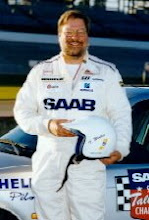For those who have followed the saga of Fart-hinder Racing (a.k.a. V.I.A.G.R.R.A.), you may recall that we have had several other engines, all 2.1-liter normally-aspirated from 1991-93 Saab 900s. The engine that we ran last year at Road America was Engine #3. It had about 200,000 miles on it when it was put in the racer, and has about 40 racing hours between Iowa (2011) and R.A. (2012) on top of that. It puffed a bit of smoke out the tailpipe when shifting. A compression check indicated that cylinder #1 was weak.
 |
| At least it looked good. |
 |
| Bolt for A/T on the left, for manual gearbox on the right. |
With only a short amount of running time on the "new" engine, water was discovered in the oil. That turned out to be a couple of timing cover bolts that are hidden behind the water pump pulley. And they are critical bolts, sealing an area where a major water passage feeds the water pump. Under pressure, water from the cooling system could leak into the oil, which it did. Replacement of those bolts did not take, so we chose not to race rather than risk destroying the engine.
 |
| Circles are where the flywheel bolts pushed against the rear bearing housing |
So Engine #3 is back in play. A teardown revealed rather worn rod bearings (down to the copper), and mildly worn main bearings, but the crankshaft looks pretty good. New bearings, new seals and it should be running. Not certain yet which head will be used. Either take the cams from a good head and use them in the planed head, or take a head into the machine shop and have a full valve job done.
As if that were not enough, Mike at Hanover European Parts has offered us a running engine. That would be engine #5. It would be nice to have a known running engine as a backup.
We have decided to take the car to an Open Track Day at Brainerd in early September. They have a special rate for ChumpCar teams, and we can have up to five drivers. Looks like we have a full slate lined up already, with five of us hoping to get some track time.






We used the engine provided by Hanover European Parts - engine #5 - for the 16-hour race at Road America. It performed flawlessly.
ReplyDelete